When thinking about the GSO Eight Cassegrain telescope, its worthwhile to look back to Laurent Cassegrain who was a 17th century French Roman Catholic priest and is given credit for inventing the telescope design that carries his name. Cassegrain telescopes use a parabolic primary mirror with a hyperbolic secondary mirror. The secondary mirror directs the light through a hole in the center of the primary mirror where it comes to focus. Most Cassegrains have focal ratios (f/#) between 12 and 20.
Variations of Cassegrain telescopes have been developed over the years with names such as Schmidt-Cassegrain, Ritchey–Chrétien Cassegrain, and Dall-Kirkham Cassegrain, to name a few. With all these variations, the original Cassegrain design is commonly referred to as the classical Cassegrain.
While the first telescopes were refractors, the first reflector was made by Isaac Newton and is referred to as a Newtonian. For most of the next century, the largest telescopes made were Newtonians.
By the mid-nineteenth century, Cassegrains became the preferred telescope for astronomical research for several reasons. First, the focus is behind the primary mirror. So astronomers no longer had to climb ladders to get to the eyepiece as was required with large Newtonians. Secondly, the mirror design provided long focal lengths without the need for long optical tube assemblies. Cassegrains were lighter and easier to mount on clock drives.

Cassegrains were the main research telescope for more than a century. However in the latter half of the twentieth century, cheaper Schmidt-Cassegrains and much faster Ritchey–Chrétien Cassegrains replaced them. Cassegrains have never been available in the amateur telescope market until very recently, when Guan Sheng Optical, out of Taiwan, starting manufacturing 6-, 8- and 10-inch classical Cassegrain telescopes. In this article I will review the mid-sized 8-inch Cassegrain.
I purchased an GSO Eight Cassegrain (8-inch classical Cassegrain) from Agena Astro Products (agenastro.com) out of Cerritos, California. I have purchased a lot of equipment from Agena in recent years, including a Celestron mount and a whole arsenal of eyepieces. The company offers fast service, free shipping, great prices, and superb customer service!
The telescope arrived within 5 days of placing my order. Image 1 shows the care taken in packaging the telescope. The telescope was wrapped in plastic inside form fitting Styrofoam all in a double-layered cardboard box. Everything arrived in mint condition.
Like all telescopes sold by Agena, the GSO Eight Cassegrain was evaluated physically, mechanically and optically before it was shipped. To test the optics, they performed a Foucault Test at the center of curvature of the primary mirror to evaluate the quality of the mirror’s conic shape; a Ronchi grating test at the center of curvature at inside focus, at focus, and at outside focus to qualitatively evaluate the primary mirror smoothness and figure; and they collimate the complete telescope and performed an autocollimation test with an artificial star to examine the overall system’s image performance at the focus point. After it arrived, I performed a star test and found it to be in perfect collimation.

The telescope came with a tube cover, a GSO two speed focuser, one 2-inch extension ring, two 1-inch extension rings, two-dovetail plates, and an installed finderscope base. The extenders are required in various combinations between the back of the telescope and the focuser to achieve the proper distance to focus the telescope with a diagonal or CCD camera.
One of the two installed dovetail plates is the wide Losmandy style, while the other is the narrow Vixen style. This allows the telescope to be attached to virtually any commercial German equatorial mount! I supplied my own 2-inch diagonal, 8x50mm right angle finderscope, mount and eyepieces.
I just happened to have saved my JMI telescope case that I previously used with an 8-inch Schmidt-Cassegrain telescope that I no longer owned. At 25 inches long, the 8-inch GSO Cassegrain perfectly fit in the case (Image 2).
Image 3 shows the telescope mounted on a Celestron CGEM II mount (see ATT Volume 11, Issue 1). This mount is more than capable of handling this 18.2-pound optical tube assembly (OTA). With the diagonal, eyepiece and finderscope attached, the total payload is near 20 pounds, only half the maximum capacity of the mount.
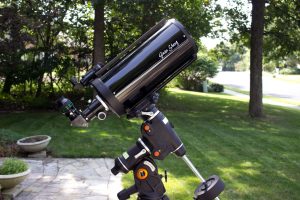
As can be seen in Image 3, the GSO Eight Cassegrain has a beautifully crafted black metal tube, although it can be purchased with a white tube. The finderscope dovetail shoe can be mounted on the right- or left-hand side of the telescope. In this image, I have not installed any of the focuser extension rings. However to achieve focus with the 26mm Tele Vue Nagler eyepiece shown in the image, the 2-inch extension ring was required.
This light telescope balanced easily with only one CGEM II counterweight. For balance along the declination axis, I had to slide the OTA all the way down to the focuser end of the dovetail plate. Using this OTA with a large, heavy CCD camera might require a counterweight attached to the other end of the dovetail plate.
The inside of the OTA is visible in Image 4. The primary mirror and reflection of the secondary mirror are clearly seen. The inside is painted flat black with ample baffling to eliminate stray light striking the mirrors and improve contrast. The secondary can easily be collimated using an Allen wrench. The secondary mirror obstruction is 33% by diameter, similar to a Schmidt-Cassegrain telescope. But it is a much smaller obstruction than found in Ritchey-Chrétiens Cassegrain telescopes, which run between 40% and 50%.
Both mirrors are quartz with a 96% reflectivity coating, par for most commercial reflectors. The primary mirror does not move during focusing, unlike that in a Schmidt-Cassegrain telescope. So focusing results in no image shift or collimation issues. Unlike a Schmidt-Cassegrain, the classical Cassegrain has no corrector lens covering the OTA. Therefore, dew control is not a major concern using this telescope.
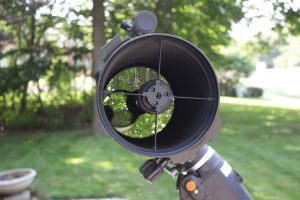
The GSO focuser appears in Image 5. This is the standard two-speed GSO Crayford focuser. The left side has a course focuser knob while the right slide has both a course and 10:1 fine focus knob. The drawtube is graduated for recording positions. The locking screw on top has a generous-sized knob! This is a pretty good focuser for a $900 telescope. For visual use, it does the job. It is not a smooth and easy to use as a Feathertouch or JMI EV-1 focuser. But you would pay a major fraction of the cost of the telescope to upgrade to a better focuser. I would not recommend that for visual use.
First light with the telescope and CGEM II mound occurred in Jubilee College State Park in Illinois, a dark sky site northwest of Peoria. The transparency was superb that night, and the seeing was around 2 arcseconds. With a 2436mm focal length, I knew I would need a perfect polar alignment to have GOTO commands centering any called object in the eyepiece. So I took extra care in performing a polar alignment of the mount.
I mainly used two eyepieces, a 26mm Tele Vue Nagler (96x) and a 13mm Tele Vue Ethos eyepiece (188x). The high magnification with the 26mm meant I was not going to see all of M31 or the double cluster in Perseus. Conversely, to be able to see high power views of star clusters and galaxies without using smaller eyepieces, which have less eye relief and exit pupils, was quite enjoyable.
Focusing was easy. In the 26mm eyepiece I saw no hint of coma or any other aberrations. Stars were pinpoint throughout the field of view. The same was true with the 13mm Ethos. At 188x, the GOTO mount still placed every object I requested near the center of the eyepiece.

The views through this telescope were splendid. I felt the optical performance and views were much cleaner than through a Schmidt-Cassegrain and more in line with a long focal length Newtonian. I just didn’t have to climb a stepladder to get to the eyepiece.
Jupiter and Saturn were above the horizon, so I popped in my 8.8mm (277x) Explore Scientific 82° eyepiece into the diagonal. Jupiter’s Great Red Spot, belts and zones were clearly visible. I did not observe any moon transits, but this would be an excellent scope to watch them. Saturn’s rings and the Cassini division were easily acquired. Saturn’s large moon and three of its medium-sized moons were immediately spotted.
For my second night of use, I place the telescope on Celestron Advanced VX mount. This mount is much smaller than the CGEM II, but still easily capable of carrying this classical Cassegrain. The single counterweight that comes with the Advanced VX was insufficient for the weight of the telescope. So I added two 2.5-pound steel discs on top the counterweight to achieve balance. This mount and telescope configuration appear in Image 6.
The smaller mount uses the Vixen-style dovetail plate. So the telescope appears upside down in Image 6. The telescope has no tapped holes to move the finderscope on top of the OTA in this configuration. However I really enjoyed having the finderscope eyepiece lower than the telescope eyepiece as I could get to it from a seated position. I did my best again to achieve a perfect polar alignment using the mount’s polar alignment scope. With the Advanced VX mount, I also was able to get the telescope to center on any object regardless of which Tele Vue eyepiece I used. For visual use, this mount works great with the telescope.
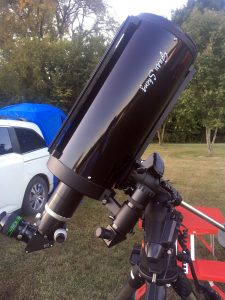
I next tested the mount imaging capabilities. But before I explain results, let me say I would not recommend an f/12 telescope to anyone who wants to do serious deep space imaging. This is too slow of a focal ratio. Longer exposures and better tracking will be required than with smaller focal ratio 8-inch telescope. Even with a 0.8x focal reducer, the focal ratio would be f/9.6.
For imaging, I would recommend the GSO 8-inch f/8 Ritchey–Chrétien, which costs the same as the GSO classical Cassegrain. The Ritchey–Chrétien is designed for imaging, but with its 40% secondary obstruction, it doesn’t perform as well for visual use as the GSO classical Cassegrain.
Using the CGEM II mount and attaching a Canon Rebel T3i DSLR camera prime focus to the telescope, I obtained an image of the almost full Moon. The seeing was nowhere as good the night I did imaging, however the moon shot was acceptable.
Unfortunately, the 2436 mm focal length was too great to capture the entire Moon in the field of view. With a 0.8x focal reducer, the entire Moon diameter can be captured with this camera. I used the live mode feature on the camera to focus the telescope. Focusing was challenging with the GSO focuser and more difficult than with the JMI EV-1 focuser that I installed on my 8-inch GSO Ritchey–Chrétien.
Finally, I decided to try a deep space image. I attached an SBIG STF-8300C CCD camera to the telescope to shoot the Great Globular Cluster in Hercules (M13). Image 7 shows the results of an unguided 10-minute exposure. In this image, east is up and north is to the right. The
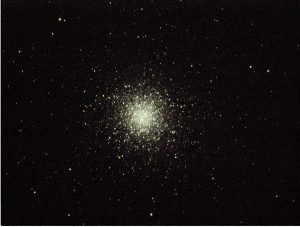
slight elongation of stars in the right ascension direction is due to the periodic error in the mount, which I did not correct. Otherwise, I see no hint of coma or field curvature on the image. This attests to the great quality of the telescope.
In conclusion, the GSO eight-inch classical Cassegrain telescope is an excellent all-around telescope for visual use. You won’t have dew and image shift issue like Schmidt-Cassegrains. The price is excellent, even with the additional cost of a finderscope, diagonal, and low-end GOTO German equatorial mount. The views are as good or better than a Newtonian since there is less coma and a longer focal length.
Unlike a Newtonian on a German equatorial mount, the eyepiece will always be at a comfortable viewing position, especially when seated. The telescope can be used on an Alt-Azimuth mount. But because of the long focal length, I would not recommend using it on an Alt-Az mount that has no tracking.
By Dr. James R. Dire
 James Dire has an M.S. degree in physics from the University of Central Florida and M.A. and Ph.D. degrees from The Johns Hopkins University, both in planetary science. He has been a professor of physics astronomy at several colleges and universities. He is the president of Methodist College in Peoria, Illinois. He has played a key role in several observatory projects including the Powell Observatory in Louisburg, KS, which houses a 30-inch (0.75-m) Newtonian; the Naval Academy observatory with an 8-inch (0.20-m) Alvin Clark refractor; and he built the Coast Guard Academy Astronomical Observatory in Stonington, CT, which houses a 20-inch (0.51-m) Ritchey Chrétien Cassegrain.
James Dire has an M.S. degree in physics from the University of Central Florida and M.A. and Ph.D. degrees from The Johns Hopkins University, both in planetary science. He has been a professor of physics astronomy at several colleges and universities. He is the president of Methodist College in Peoria, Illinois. He has played a key role in several observatory projects including the Powell Observatory in Louisburg, KS, which houses a 30-inch (0.75-m) Newtonian; the Naval Academy observatory with an 8-inch (0.20-m) Alvin Clark refractor; and he built the Coast Guard Academy Astronomical Observatory in Stonington, CT, which houses a 20-inch (0.51-m) Ritchey Chrétien Cassegrain.
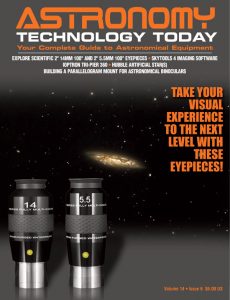 And to make it easier for you to get the most extensive telescope and amateur astronomy related news, articles and reviews that are only available in the magazine pages of Astronomy Technology Today, we are offering a 1 year subscription for only $6! Or, for an even better deal, we are offering 2 years for only $9. Click here to get these deals which only will be available for a very limited time. You can also check out a free sample issue here.
And to make it easier for you to get the most extensive telescope and amateur astronomy related news, articles and reviews that are only available in the magazine pages of Astronomy Technology Today, we are offering a 1 year subscription for only $6! Or, for an even better deal, we are offering 2 years for only $9. Click here to get these deals which only will be available for a very limited time. You can also check out a free sample issue here.



